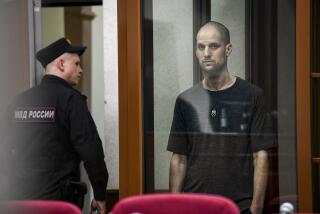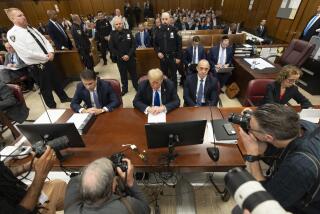Spy Will Take Stand in Miller Defense Gamble
An unpredictable Russian emigre who twice disrupted her own spy trial with courtroom outbursts is scheduled to take the witness stand in a Los Angeles federal courtroom Tuesday in a dramatic gamble by the defense expected to provide the most sensational testimony in the espionage retrial of Richard W. Miller.
While there is no certainty as to what convicted Soviet agent Svetlana Ogorodnikova will say on the witness stand, lawyers have predicted for months that she could transform Miller’s second spy trial into a “circus” if allowed to recount fully her version of the events leading to the arrest of the first FBI agent ever charged with espionage.
Ogorodnikova’s Claims
Fearful that Ogorodnikova’s testimony could obscure the government’s case against Miller and jeopardize an 18-month effort to convict him, the government scrambled unsuccessfully last week to block her testimony, first by moving to limit it to the few months of her actual involvement with Miller, then by trying to cancel it altogether by denying her immunity.
Among the claims Ogorodnikova allegedly made in the past to the FBI are that she was the former lover of the late Soviet Premier Yuri Andropov and a major in the Soviet KGB, although her own lawyers maintained last year that she was actually just an emotionally troubled and alcoholic meatpacker’s wife with an IQ of 74, unhappy with her life in the Russian immigrant community of West Hollywood.
More crucial to Miller’s defense is another of Ogorodnikova’s claims that before a sexual relationship with Miller that began in May, 1984, she had a previous sexual affair with another FBI counterintelligence agent, John Hunt, who has branded the charge a “malicious” falsehood.
When Hunt testified against Ogorodnikova in her trial last April 27, saying he had rejected her sexual advances during an effort to recruit her as an FBI informant, she interrupted court proceedings by shouting “Why you lie?” and collapsed into tears.
As U.S. District Judge David V. Kenyon quickly declared a recess, she continued to shout at Hunt: “But he lie! I tell it to everybody. It’s not true. He will pay for that.” Her second outburst came later in the trial when she again broke into tears as Miller testified about his sexual relationship with her in 1984.
Ogorodnikova, 35, and her husband, Nikolai, 53, were arrested with Miller Oct. 2, 1984, on charges of conspiring to pass secret FBI documents to the Soviet Union. The trial of the Ogorodnikovs preceded Miller’s two trials, and ended last June in a plea bargain agreement in which Ogorodnikova was sentenced to 18 years in prison and her husband to an eight-year term.
While Ogorodnikova could conceivably confuse almost all the key issues in the Miller case and hurt the prosecution by attacking Hunt, her testimony also could possibly backfire on the defense on the subject of whether Miller actually gave her FBI documents and conspired with her to help the Soviet Union.
Denied Receiving Documents
Miller’s lawyers, Stanley Greenberg and Joel Levine, have pointed out that Ogorodnikova has denied receiving any secret FBI documents from Miller on at least three occasions during various court proceedings. However, during her guilty plea last year, she agreed that she had “unlawfully” conspired with Miller to pass secrets to the Soviet KGB.
As she stood before Kenyon during her guilty plea, one of her lawyers, Brad Brian, summarized her involvement with Miller in 1984, describing a pivotal trip to the Soviet Consulate in San Francisco that August.
“In August of 1984, Miller told her that he wanted to work for the Soviet government,” Brian said. “He told her that he would sell the Russians everything they wanted. . . . Miller gave her a handwritten note and his FBI credentials to take inside the Soviet Consulate to show a consular official. The purpose of the trip was to try to arrange a meeting between Miller and a Soviet intelligence officer.
“Is that a correct statement?” Brian then asked Ogorodnikova.
“Yes,” she said, also acknowledging that she knew she was in violation of the law by later planning a trip with Miller to Eastern Europe to deliver secret documents to Soviet officials.
Miller’s lawyers revealed how they plan to cope with the potential problems presented by Ogorodnikova’s testimony by telling Kenyon last week that they plan to call Ogorodnikova twice to present her story in “chronological” order.
Focus on Hunt’s Relationship
That means they will begin their questioning with the period preceding her 1984 involvement with Miller, focusing on the earlier relationship with Hunt. Depending on what she says, the prosecution would be faced with the problem of whether to attempt to brand her as a liar, which could subsequently help the defense attack her credibility if she later incriminates Miller.
While the last-minute efforts by U.S. Atty. Robert C. Bonner and Assistant U.S. Atty. Russell Hayman to block Ogorodnikova’s testimony created a public impression of a sudden government flip-flop, the jury deciding Miller’s fate saw nothing of the courtroom chaos and personal rebukes to Bonner from Kenyon that resulted from the unsuccessful prosecution moves.
The courtroom action outside the presence of the jury--leading to a threat by the judge to cite Bonner for contempt of court--obscured the fact that the second Miller jury saw essentially the same prosecution case as the one presented during Miller’s first trial, which ended in a deadlock heavily tipped in favor of convicting the ex-agent on seven counts of espionage and related bribery charges.
Unlike the first Miller trial, which frequently packed Kenyon’s courtroom with reporters and spectators, the second trial has drawn only minimal public interest. Only a few observers have followed the proceedings on a daily basis, most of them FBI agents assigned to the trial as witness coordinators.
Kenyon declared a mistrial in the government’s first effort to convict Miller after jurors deadlocked 10 to 2 in favor of convicting Miller on three counts of espionage and 11 to 1 on four other charges. The holdout on all seven charges was Virgina Hennes, an Orange County mental health worker.
Claimed No Changes
As the government prepared for the second trial, one aim was to keep individuals with mental health backgrounds off the jury, which proved to be easy. While the government claimed it planned no changes in the second trial, private concerns were with Hunt’s credibility and with complaints from some jurors of “prosecution overkill.”
While the prosecution unsuccessfully tried to keep Hunt’s 1982 meetings with Ogorodnikova hidden from the second jury on grounds that it was irrelevant to the question of Miller’s alleged crimes, Hunt ended up essentially telling the same story he had told in the first trial, which some jurors cited as a factor in the deadlock.
At the same time, however, the government responded to the criticism of overkill by cutting its witness list from 70 to 63, while still emphasizing the testimony of a half-dozen witnesses whose accounts were particularly damaging to Miller. Among them were FBI agents and one of Miller’s former girlfriends, Marta York, who testified that Miller had confessed passing secret documents to Ogorodnikova after first denying that he had ever possessed any such documents.
The key document allegedly passed by Miller was a compilation of U.S. intelligence goals throughout the world known as the FBI’s Positive Intelligence Reporting Guide. Before his arrest, Miller allegedly drew a map of his house for the FBI, pinpointing the exact spot where he allegedly handed it to Ogorodnikova.
As the prosecution neared the end of its case on Friday, after four days of testimony by Hunt, it presented two expert witnesses to testify on the potential damage to U.S. security by Moscow’s alleged receipt of the FBI document.
Retired Gen. Richard A. Larkin, former deputy director of the U.S. Defense Intelligence Agency, said the secret document would be “extremely useful” to the Soviet Union.
Secret Game Plan
“It is basically our collection plan, our game plan,” he said. “It would betray what areas we are ignorant of, what areas we are not ignorant of. It would enable the Soviets to establish countermeasures, enable them to develop disinformation schemes to give us screwy answers to our questions.
“It has a direct bearing on the national defense and security,” Larkin continued. “It tells the Soviets exactly what we are after.”
The prosecution’s last witness was John Barron, a senior editor for the Reader’s Digest and author of “KGB Today: The Hidden Hand,” a book used as a training manual for many intelligence and counterintelligence agencies.
Bonner, citing a list of problems identical to Miller’s problems with his penchant for adultery, his poor financial situation, his career setbacks, his unhappy marriage and his excommunication from the Mormon Church, asked Barron if such problems would mark an American as a particularly attractive target for recruitment by the Soviet KGB.
“They look for people with character weaknesses and personality defects,” Barron said. “You’ve drawn the ideal KGB profile.”
More to Read
Sign up for Essential California
The most important California stories and recommendations in your inbox every morning.
You may occasionally receive promotional content from the Los Angeles Times.










